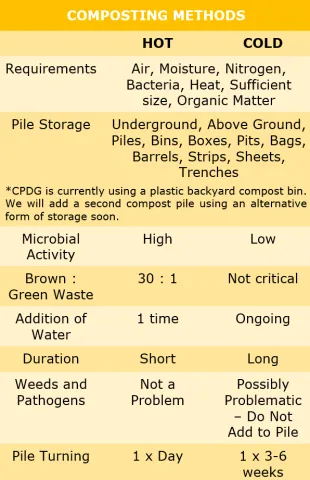By Lesley Truett, UC Master Gardener
Welcome to North County's Coolest Compost Plot!
There are many methods of composting. Our goal at Centennial Park Demonstration Garden (CPDG) is to provide home gardeners with an approachable solution that takes as little time, money, and effort as possible. The answer – cold composting. Simply select a means to store your compost pile, add a mix of brown and green waste over time, aerate the pile by turning every few weeks, keep the pile moist, and protect the pile from rodents and other pests. This will produce a rich soil amendment over a matter of months. Need compost now? Consider hot composting.
Why Compost
What is Composting Composting produces a soil amendment by using naturally occurring fungi and bacteria to break down organic waste. The process involves biological decomposition of organic material, sanitization through heat, and stabilization of the final product. As bacteria, yeast and fungi diges the waste, nutrients are readilyavailable. When compost is added to soil, the nutrients are slowly released over time for up-take by the plants. Composting reduces large amounts of waste into smaller piles of natural soil conditioner. |  |
What Goes In
Fruits, vegetables, coffee grounds, teabags (non-plastic), egg shells, nut shells, breads, grains, pasta, unbleached paper, non-invasive weedy plants and flowers.
What Stays Out
Meat, fish, shellfish, bones, dairy, all plastics, compostable cutlery, packaging and plates, bleached paper including paper towels, napkins and paper egg cartons, weeds, large branches and pet waste.
Instructions
- Place a layer of “greens” followed by a layer of “browns” that is at least double the amount of the layer of greens.
- Continue this layering throughout the process of building your compost pile.
- When your pile heats up, you can turn your pile, though it’s not required. An unturned static pile will decompose, but not as quickly.
- If your bin is completely filled, create a secondary pile. Your secondary pile should be in a space that is at least three feet long and three feet wide.
- To avoid pests, contain your secondary pile in an additional plastic bin, metal fencing or a homemade wooden compost bin.
References and Resources
Composting. Sea Grant UCCE. https://ucanr.edu/sites/ucmgnevada/files/322418.pdf
Composting is Good for Your Garden and the Environment. PDF. UC ANR. Composting Is Good for Your Garden and the Environment (ucanr.edu)
Giesel, Pamela, and Carolyn Unruh. 2007. Compost in a Hurry. PDF. UC ANR. Compost in a Hurry (ucanr.edu)
Hopkins, Roberta, and Louise Lelevich. 2015. Composting for the Home Gardener. PDF. UC ANR. Microsoft Word - EH 98 Composting for the Home Gardener (ew) (ucanr.edu)
